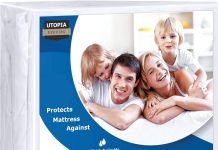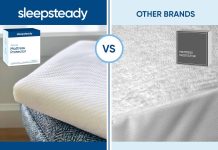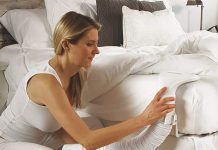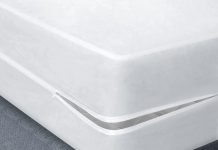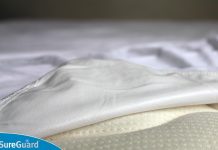Maintaining a clean and hygienic sleep environment is crucial for our overall well-being. With that in mind, one often overlooked yet essential item in our bedroom is the mattress protector. But, have you ever wondered how often it should be cleaned? From preventing dust mites and allergens to extending the life of our mattress, the importance of regular cleaning cannot be underestimated. In this article, we will explore the recommended frequency for cleaning mattress protectors, ensuring that we enjoy a restful and healthy night’s sleep.
Review contents
Importance of Cleaning Mattress Protectors Regularly
Maintaining a clean and hygienic sleeping environment is crucial for our overall health and well-being. While most of us know the importance of regularly cleaning our bedsheets and pillowcases, we often overlook the need to clean our mattress protectors. However, cleaning mattress protectors regularly is equally important for several reasons.
Prevent Allergens and Dust Mites
Our mattresses are often a hotbed for allergens and dust mites. These microscopic creatures can trigger allergies and respiratory issues, particularly for individuals who are sensitive or have respiratory conditions such as asthma. Regularly cleaning mattress protectors can help prevent the accumulation of allergens and dust mites, promoting a healthier sleeping environment for all.
Increase the Lifespan of the Mattress
Investing in a high-quality mattress is a wise decision, but it’s equally important to protect that investment. Mattress protectors act as a barrier against spills, stains, and general wear and tear. By regularly cleaning these protectors, we can prolong the lifespan of our mattresses, ensuring they stay in optimal condition for many years to come.
Maintain Hygiene and Freshness
Our bodies naturally shed dead skin cells while we sleep, and some of these cells can end up on our mattress protectors. Additionally, sweat and body oils can also seep into the protectors over time. Regular cleaning of mattress protectors helps to keep them fresh and free from the buildup of these bodily fluids, maintaining a clean and hygienic sleeping surface.
Prevent Stains and Odors
Accidents happen, and spills or bedwetting incidents can occur from time to time. By promptly cleaning mattress protectors, we can prevent stains from setting in and avoid unpleasant odors. This proactive approach ensures that our sleeping surface remains clean and fresh, allowing us to enjoy a more comfortable and odor-free night’s sleep.
Factors That Influence Cleaning Frequency
The frequency at which mattress protectors should be cleaned varies based on several factors. Understanding these factors can help us determine how often we should clean our mattress protectors.
Usage Frequency
The more frequently we use our mattress, the more dirt, sweat, and body oils will accumulate on the protector. If we sleep on the mattress every night, it is advisable to clean the mattress protector more frequently compared to someone who uses it occasionally.
Personal Habits
Our personal habits also play a role in determining cleaning frequency. If we have a habit of eating or drinking in bed, the chances of spills and stains increase. Similarly, if we sweat excessively or have oily skin, our mattress protectors may require more frequent cleaning.
Environmental Conditions
The environment in which we live can impact the cleanliness of our mattress protectors. If we live in a dusty area or have pets that shed fur, the protectors may need more frequent cleaning to remove allergens and hair.
Pet Ownership
Pets bring joy and companionship to our lives, but they also bring their fair share of dirt and allergens. If we have pets that sleep on our beds, it is important to clean our mattress protectors more frequently to remove any pet dander, fur, or stains.
Recommended Cleaning Schedule
To help maintain a clean and healthy sleeping environment, we recommend following a regular cleaning schedule for mattress protectors. The frequency of cleaning may vary based on individual circumstances, but here are some general guidelines to follow:
Every 2-4 Weeks
For individuals who don’t have any specific issues or allergies, cleaning the mattress protector every 2-4 weeks is typically sufficient. This frequency allows for the removal of dust, sweat, and any general buildup that may occur.
Every 3-6 Months
If you have allergies or respiratory conditions, it may be beneficial to clean your mattress protector every 3-6 months. This more frequent cleaning schedule helps minimize allergens and dust mites, promoting a cleaner sleeping environment.
Every 6-12 Months
For individuals who take extra precautions and use additional layers of protection, such as mattress pads or toppers, cleaning the mattress protector every 6-12 months may be sufficient. However, it’s important to remember that personal factors such as usage frequency and environmental conditions should also be considered.
Cleaning Method for Mattress Protectors
Cleaning mattress protectors is a fairly simple process that can be done at home. Here is a step-by-step guide to follow:
Read the Care Instructions
Before cleaning the mattress protector, it’s important to read and follow the care instructions provided by the manufacturer. Different materials and brands may have specific requirements, so it’s best to follow their recommendations for optimal cleaning results.
Remove and Wash the Protector
Start by removing the mattress protector from the bed. Shake off any loose debris or dirt if necessary. If there are visible stains or spills, pre-treat them with a stain remover before washing.
Choose the Right Cleaning Products
Use a mild detergent that is suitable for delicate fabrics to ensure the protector doesn’t get damaged during the cleaning process. Avoid using bleach or harsh chemicals, as they can weaken the fabric and affect its protective properties.
Use Proper Washing Techniques
Check the care instructions to determine the appropriate water temperature and cycle settings for your mattress protector. Generally, it is recommended to wash on a gentle cycle using cold or lukewarm water. This helps prevent shrinking or damage to the fabric.
Dry the Protector Appropriately
Once the washing cycle is complete, remove the mattress protector from the machine and let it air dry. Avoid using high heat or direct sunlight, as these can cause the fabric to shrink or become brittle. Instead, hang it out to dry or lay it flat on a clean surface.
Signs That Your Mattress Protector Needs Cleaning
While following a regular cleaning schedule is the best way to maintain a clean mattress protector, there are some signs that indicate it may be time for a cleaning:
Visible Stains or Spills
If you notice any visible stains or spills on your mattress protector, it’s a clear sign that it needs to be cleaned. Promptly addressing these stains can help prevent them from setting in and becoming more difficult to remove.
Unpleasant Odors
If your mattress protector starts emitting an unpleasant odor, it’s a strong indication that it needs cleaning. Body oils, sweat, and spills can lead to the buildup of bacteria and mold, resulting in unwanted odors. Cleaning the protector will help eliminate these odors and keep your sleeping environment fresh.
Increased Allergic Reactions
If you or your partner start experiencing increased allergic reactions, such as sneezing, itching, or congestion, it may be a sign that your mattress protector contains allergens or dust mites. Cleaning it more frequently can help reduce these allergic triggers and provide relief.
Feeling Dirty or Uncomfortable
Trust your instincts. If your mattress protector feels dirty or uncomfortable, it’s a good indication that it needs cleaning. Regular washing will help remove dirt, sweat, and bodily fluids, restoring the freshness and comfort of your sleeping surface.
Special Considerations for Waterproof Mattress Protectors
Waterproof mattress protectors offer an additional layer of protection against spills and stains. However, they require special care to maintain their effectiveness and longevity.
Cleaning Frequency for Different Types
The cleaning frequency for waterproof mattress protectors may vary depending on the type and brand. Some waterproof protectors can be cleaned every 2-4 weeks, while others may require more frequent cleaning due to their specific design and material.
Extra Steps for Deep Cleaning
Deep cleaning a waterproof mattress protector involves additional steps to ensure proper maintenance. Start by wiping away any surface dirt or spills with a damp cloth. Then, follow the regular cleaning method mentioned earlier to remove any remaining stains or odors.
Maintenance Tips to Extend Longevity
To extend the lifespan of your waterproof mattress protector, consider the following maintenance tips:
- Avoid using high heat when drying, as this can damage the waterproof layer.
- Inspect the protector regularly for any wear and tear. If you notice any rips or tears, replace it promptly to maintain the waterproof barrier.
- If your protector has a removable top layer, wash and dry it separately to ensure thorough cleaning.
Tips for Maintaining Clean Mattress Protectors
In addition to regular cleaning, there are several other measures we can take to maintain clean mattress protectors and promote a healthier sleeping environment:
Regularly Vacuum the Mattress
Using a vacuum cleaner with a brush attachment, gently vacuum the surface of the mattress protector to remove any dust, allergens, or loose debris. This helps keep it clean and prevents the buildup of irritants.
Use Additional Layers of Protection
Consider using additional layers of protection such as mattress pads or toppers. These extra layers can help absorb sweat, spills, and stains, reducing the likelihood of them reaching the mattress protector.
Avoid Eating or Drinking on the Bed
While it may be tempting to indulge in a late-night snack or have a cup of coffee in bed, it’s best to avoid eating or drinking on the bed. This reduces the risk of spills and stains, ultimately keeping the mattress protector cleaner for longer.
Address Stains Immediately
If you accidentally spill something on your mattress protector, address the stain immediately. Blot the stain gently using a clean cloth or paper towel, avoiding rubbing it in further. Promptly cleaning the stain can prevent it from setting in, making it easier to remove later.
Professional Cleaning Services
While cleaning mattress protectors regularly at home is often sufficient, there may be situations where professional cleaning services are beneficial.
Benefits of Professional Cleaning
Professional cleaning services have specialized equipment and expertise to remove tough stains and deeply embedded dirt. They can also provide a thorough cleaning that may not be achievable at home, particularly for mattress protectors with intricate details or delicate fabrics.
How Often to Hire Professionals
The frequency of hiring professional cleaning services for mattress protectors depends on personal preference and the condition of the protector. If you notice stubborn stains or find it challenging to clean your protector effectively at home, it may be time to seek professional help.
Factors to Consider When Choosing a Service
When choosing a professional cleaning service, consider their experience, reputation, and the methods they use to clean mattress protectors. It’s important to select a service that understands the intricacies of mattress protector care and uses safe cleaning techniques to ensure the longevity of your protector.
DIY vs. Professional Cleaning
Determining whether to opt for DIY or professional cleaning depends on various factors such as personal time availability, cleaning expertise, and the condition of your mattress protector. If you have the time and confidence to clean the protector adequately at home, DIY cleaning can be a cost-effective option. However, if you prefer the convenience and expertise of professionals, hiring a cleaning service may be the better choice.
Common Mistakes to Avoid
While cleaning mattress protectors is a relatively straightforward task, there are some common mistakes that we should avoid:
Using Harsh Chemicals
Using harsh chemicals such as bleach or strong detergents can damage the fabric and compromise the protective properties of the mattress protector. Stick to mild, gentle detergents to ensure a thorough yet safe cleaning process.
Overlooking Cleaning Instructions
Every mattress protector comes with specific care instructions, and it’s important to read and follow them carefully. Overlooking these instructions could lead to improper cleaning techniques or the use of unsuitable products, potentially damaging the protector.
Skipping Regular Cleaning
Maintaining a regular cleaning schedule is essential for the optimum performance and longevity of the mattress protector. Skipping or procrastinating cleaning sessions can lead to an accumulation of dirt, stains, and allergens, impacting the cleanliness of your sleeping environment.
Not Drying Thoroughly
Properly drying the mattress protector after washing is crucial. Inadequate drying can result in a damp environment, promoting the growth of mold and mildew. Ensure the protector is completely dry before placing it back on the mattress.
Conclusion
Regularly cleaning mattress protectors is vital for a clean and healthy sleeping environment. By preventing allergens and dust mites, increasing mattress lifespan, maintaining hygiene, and preventing stains and odors, cleaning mattress protectors can significantly contribute to our overall well-being. Factors such as usage frequency, personal habits, environmental conditions, and pet ownership influence the cleaning frequency. Following a recommended cleaning schedule, using appropriate cleaning methods, and addressing signs that indicate cleaning is needed can help maintain clean and fresh mattress protectors. Additionally, special considerations for waterproof protectors, tips for maintaining cleanliness, and awareness of common mistakes to avoid ensure that our mattresses stay protected and our sleeping environment remains hygienic. Whether opting for DIY cleaning or professional services, taking these steps will ensure that our mattress protectors continue to deliver the protection and comfort we need for a good night’s sleep.


